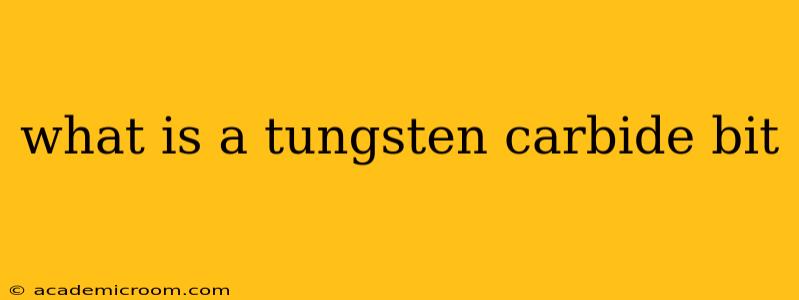Tungsten carbide bits are exceptionally hard and durable cutting tools used in a variety of applications requiring high resistance to wear and tear. Their strength and longevity stem from the incredibly strong chemical bonds between tungsten and carbon atoms, forming a material far harder than steel. But what exactly is a tungsten carbide bit, and what makes it so special? This comprehensive guide will explore the material, its applications, and answer frequently asked questions.
What are Tungsten Carbide Bits Made Of?
Tungsten carbide bits are manufactured by combining tungsten carbide powder with a metallic binder, typically cobalt. This mixture is then subjected to high-temperature sintering, a process that fuses the particles together to create a solid, incredibly tough material. The proportion of tungsten carbide to cobalt impacts the bit's overall properties; a higher tungsten carbide percentage generally results in greater hardness but reduced toughness.
The resultant material possesses an exceptional combination of properties:
- Extreme Hardness: Tungsten carbide boasts a hardness second only to diamond, making it ideal for cutting through tough materials.
- High Wear Resistance: Its resistance to abrasion and wear is significantly higher than high-speed steel, leading to extended tool life.
- High Compressive Strength: It can withstand significant pressure without fracturing, crucial for drilling and cutting applications.
- High-Temperature Resistance: Tungsten carbide retains its hardness and strength even at elevated temperatures, allowing for efficient cutting in demanding conditions.
What are the Different Types of Tungsten Carbide Bits?
The design and specific applications of tungsten carbide bits vary widely. Here are some common types:
- Drill Bits: Used for drilling holes in various materials, ranging from wood and metal to stone and concrete. Sizes and geometries are tailored to specific materials and drilling needs.
- Router Bits: These bits are used in routers to create intricate shapes and patterns in wood, plastics, and other materials. Different profiles (e.g., straight, roundover, chamfer) cater to diverse woodworking applications.
- Milling Cutters: Employed in milling machines to remove material from workpieces, creating precise shapes and dimensions. These cutters often have multiple cutting edges for increased efficiency.
- End Mills: A specific type of milling cutter with cutting edges on the end and sides, capable of creating both axial and radial cuts.
- Reamer Bits: Used to enlarge existing holes to a precise diameter. These are crucial for ensuring accurate fits in machining operations.
What are the Advantages of Using Tungsten Carbide Bits?
The superior performance of tungsten carbide bits translates to several key advantages:
- Extended Tool Life: Their exceptional durability means fewer replacements and reduced downtime.
- Increased Productivity: Faster cutting speeds and improved efficiency lead to higher output.
- Precise Cuts: The hardness ensures cleaner, more accurate cuts, reducing the need for rework.
- Versatility: Tungsten carbide bits are used across a broad range of materials and applications.
- Cost-Effectiveness (Long Term): While the initial cost might be higher than other bit types, the extended lifespan ultimately leads to cost savings over time.
What Materials Can Tungsten Carbide Bits Cut?
Tungsten carbide bits are capable of cutting through a wide variety of materials, including:
- Steel: Various grades of steel, from mild steel to hardened steel.
- Cast Iron: A common material in machinery and engine components.
- Aluminum: A lightweight and widely used metal.
- Wood: Different types of wood, depending on the bit design.
- Stone: Natural and artificial stone materials, like granite and marble.
- Concrete: Used in construction and demolition.
- Plastics: Various types of plastics and composites.
How Do I Choose the Right Tungsten Carbide Bit?
Selecting the appropriate tungsten carbide bit depends on several factors:
- Material to be cut: The hardness and composition of the material dictate the required bit type and geometry.
- Application: The specific task, such as drilling, milling, or routing, influences the bit's design.
- Size and shape: The dimensions of the hole or cut need to match the bit's specifications.
- Cutting speed and feed rate: Optimal performance requires balancing these parameters to prevent excessive wear and damage.
How Long Do Tungsten Carbide Bits Last?
The lifespan of a tungsten carbide bit varies greatly depending on the material being cut, the cutting conditions, and proper maintenance. However, they generally outlast high-speed steel bits by a significant margin, often lasting hundreds of times longer.
How to Maintain Tungsten Carbide Bits?
Proper maintenance extends the life of tungsten carbide bits. Keep the bits clean and free from debris, and store them carefully to avoid damage. Regular inspection for chipping or wear is also crucial.
This in-depth exploration of tungsten carbide bits should provide a comprehensive understanding of their composition, applications, advantages, and considerations for selection and maintenance. Remember to always prioritize safety when using any cutting tools.
